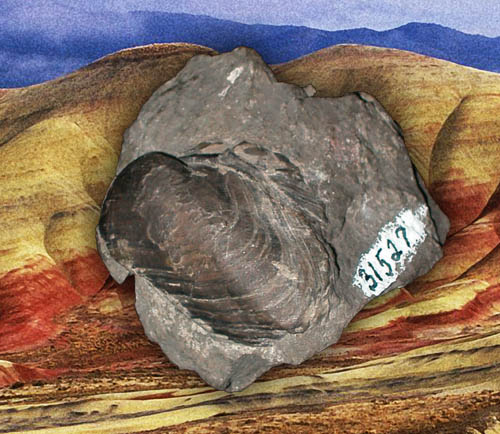| Page last updated
27 February 2012 |
Mussel of the Month
The March 2012 Mussel of the Month is Antediplodon carolussimpsoni. Antediplodon is a genus of freshwater mussels of the Upper Triassic of North America.

ANSP 31527. Little Conewago Creek, New Oxford Formation,
Newark Supergroup [TRIASSIC]. (type).
|
To highlight the inclusion of fossil taxa into the MUSSEL Project Database, this month we have selected our first fossil as the March Mussel of the Month.
Anyone that wants to have a comprehensive understanding of freshwater mussel evolution is going to have to account for the fossil diversity. Though perhaps obvious, that desire has yet to be put into practice. The biggest obstacle to neo-paleo-synthesis is that the most valuable characters for classifying living species (i.e., soft-anatomy, larvae, behavior, DNA) are almost completely missing from the fossil record. The modern paleontological literature, by necessity, relies on shell characters. This makes it difficult to convincingly assign ancient specimens to the correct family. In some cases, even a realistic genus is unavailable. For example, many North American fossil species are still assigned to Unio. Not because of any hypothesized affinity to the modern Old World taxon, but because no meaningful alternative has been introduced.
For example, Antediplodon (from the Upper Triassic, 228-200 Mya) has been assigned to the Hyriidae because shell sculpture is similar to that of some modern hyriids. But, as Modell (1964) proved by concocting a shell-based classification that nobody follows, shell characters suffer convergent evolution worse than some other, more reliable traits. Just because two freshwater mussels have similar looking shells doesn't mean they are closely related. And, conversely, just because two freshwater mussels have different looking shells doesn't mean that they aren't closely related.
Since we don't have a better place to put Antediplodon, we will leave it in the Hyriidae, just like Modell (1957). It is interesting to note that the earliest members of the Unionoida in North America belong to family that is now limited to South America and Australasia. This is all made even more interesting my the work of Skawina & Dzik (2011) which suggests that Triassic unionoids are stem-group taxa rather than part of the extant crown group. |
To find out more about Antediplodon and the Triassic mussels of North America, check out:
- Good, S.C.. 1998. Freshwater bivalve fauna of the Late Triassic (Carnian-Norian) Chinle, Dockum, and Dolores Formations of the southwest United States. pp. 223-249. [in] P.A. Johnston & J.W. Haggart, eds. Bivalves: An Eon of Evolution .University of Calgary Press, Calgary.
- Henderson, J. 1935. Fossil non-marine Mollusca of North America. Geological Society of America, Special Paper 3: 1-313.
- Modell, H. 1957. Die fossilen Najaden Nordamerikas. Archiv für Molluskenkunde 86: 183-200.
- Modell, H. 1964. Das natürliche System der Najaden. 3. Archiv für Molluskenkunde 93: 71-126.
- Skawina, A. & J. Dzik. 2011. Umbonal musculature and relationships of the Late Triassic filibranch unionoid bivalves. Zoological Journal of the Linnean Society, 163: 863-883.
|